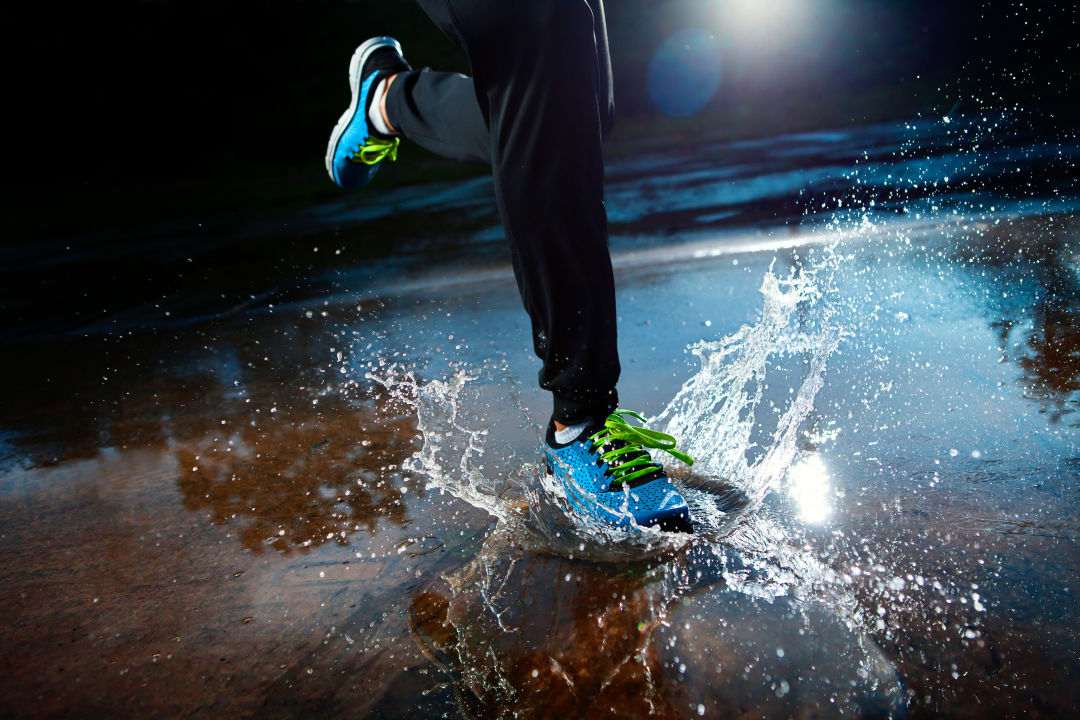10 Essential Tips for Running in the Cold, Dark, and Wet

Image: Shutterstock
In August, it’s easy to promise yourself you’ll keep running through the winter. But when that cold, damp weather starts creeping in, most of us use it as justification to drive to the bright, warm gym—or better yet, hibernate until May. (Un)fortunately, there are still plenty of pitch-black mornings left for you to earn your winter running chops … and with these terrific tips, it’s never sounded easier.
- Layer up. According to Foot Traffic’s Daniel McDuff, layers are the most important part of winter running. Start with several lightweight layers, so that if you overheat, it’s quick and easy to shed a layer. A fancy jacket with a rear pocket or removable sleeves makes this even simpler, but there’s nothing wrong with simply tying your top around your waist.
- Know your temperature. If you tend to “run hot,” it’s best to start out with fewer layers. The first half-mile may be chilly, but if you start out all snuggly warm, you’re likely to overheat in a few minutes. On the other hand, if you typically run cold and rarely overheat, it’s fine to start out in thicker layers.
- Resist water. “We’ve had a lot of rain lately, and having a water resistant jacket keep you dry for an hour, hour and a half,” says McDuff. “Waterproof tends to be really clammy and not breathe well, but walkers do need a waterproof jacket, especially if they’re training for the same distances, because then they’re out there longer.”
- Reflect light. Unless you’re lucky enough to have free time during daylight hours—that’s 8am–4pm around the winter equinox—you’ll need to trade that black jacket for something much more visible. Luckily, many water resistant jackets feature reflective panels, making visibility a breeze. Reflective vests and blinking lights also do the trick.
- Wear smart shoes. Traditional mesh running shoes aren’t super fun in rainy weather, but many models offer Gore-Tex or water resistant versions, keeping your feet warm and dry even in the dreariest downpours.
- … and smart(wool) socks. Even if your footwear claims to repel water, cozy socks are a great idea. “I really love Smartwool socks,” says McDuff. “They breathe well; they keep you warm even when they’re wet, and that’s really important, just being comfortable out there and not having super cold feet.”
- Light up. Most headlamps don’t have the lumens for a ton of visibility, McDuff explains. Trail running headlamps boast 300 lumens, but that requires a big, heavy battery pack. But for areas with street lighting, a standard Petzl or Black Diamond headlamp is enough to see right in front of you—and also alerts cars to your presence. (They’re waterproof, too!)
- Grab those gloves. If you run hot, a thin hat or earband and lightweight pair of gloves should do the trick, says McDuff. If you run cold, consider a warmer hat and a pair of mittens, which will trap a bit more heat.
- Recruit a running buddy. Despite our best intentions, it’s far too tempting to stay snuggled up in bed when that early alarm clock goes off, or opt for Netflix over evening exercise. Running partners can keep you accountable (and safe!), especially in winter—and if you’d rather not make small talk, how about a canine companion? They definitely won’t choose Jessica Jones over a jog through the neighborhood!
- Just do it! We don’t mean to quote Nike, but getting started is seriously the hardest part. Once you have a successful winter run under your belt, each successive day will feel easier and easier. If choosing your own route sounds stressful, get started almost any day of the week with these Foot Traffic group runs:
Monday: Foot Traffic West (13306 NW Cornell Blvd), 6pm
Tuesday: Foot Traffic NE (4020 NE Fremont ST.), 6pm
Wednesday: Foot Traffic SE (7718 SE 13th Ave), 6pm
Thursday: Foot Traffic DT (333 SW Taylor Ave), 6pm
Sunday: Foot Traffic SE (7718 SE 13th Ave), 10am




